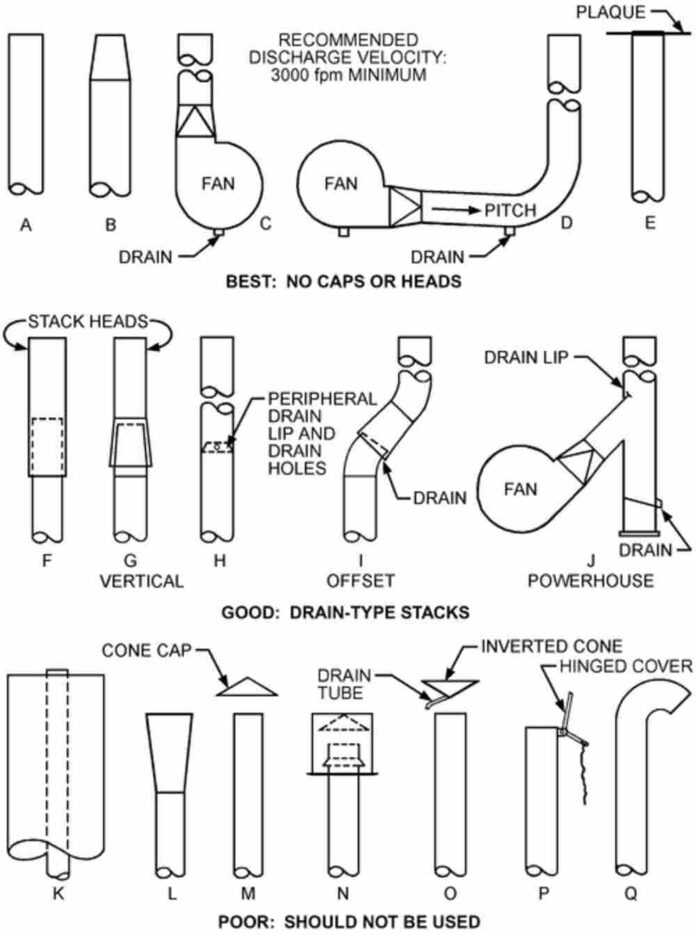Exhaust systems play a crucial role in maintaining clean, safe air within homes, laboratories, and schools. A well-designed exhaust system not only eliminates harmful pollutants but also ensures a comfortable environment by managing the flow and dispersion of emissions. At the heart of these systems are exhaust stacks and plume dynamics—elements that directly influence the effectiveness of ventilation and air quality. This article will break down the essentials of designing exhaust system stacks and the dynamics of plumes to help you understand how they can be optimized for diverse settings.
Understanding Exhaust System Stacks
Exhaust system stacks are vertical structures connected to ventilation systems, channeling exhaust gases away from the building. The design, height, and location of these stacks play a significant role in ensuring that pollutants are safely dispersed and do not re-enter indoor spaces.
Key Functions of Exhaust Stacks
1. Dispersion of Pollutants: By elevating the emissions, exhaust stacks help ensure that pollutants are dispersed at a safe distance from air intakes, windows, and building occupants.
2. Improving Indoor Air Quality: Proper stack design can prevent re-entrainment (where exhaust air is pulled back into the building) by controlling where the exhaust is released.
3. Complying with Regulations: Many regulatory bodies mandate certain standards for exhaust systems, especially in laboratories and schools where hazardous emissions are likely.
Design Considerations for Exhaust Stacks
1. Stack Height: A taller stack generally ensures better dispersion of pollutants, as emissions can travel further before interacting with the surrounding environment. However, stack height must be balanced with building codes, aesthetic considerations, and cost.
2. Material Selection: Materials must withstand both the physical and chemical characteristics of the exhaust gases, which may include corrosive substances in laboratory settings.
3. Location and Orientation: Positioning the stack away from air intakes, windows, and frequently occupied spaces minimizes the risk of pollutants re-entering the building.
4. Cap Design: Stack caps are designed to prevent rain from entering the system but can also affect airflow. Designs like conical or hinged caps can enhance dispersion and reduce turbulence within the stack.
What Is Plume Dynamics?
Plume dynamics refers to how exhaust gases behave once they exit the stack. A plume is essentially the flow or pattern of the exhaust gases as they rise, mix with the atmosphere, and disperse. In environments such as laboratories or schools, where harmful gases might be present, understanding and controlling plume behavior is essential.
Factors Influencing Plume Dynamics
1. Exit Velocity: The speed at which gases are expelled from the stack influences how quickly they disperse. A higher exit velocity can project pollutants further away, reducing the risk of them settling nearby.
2. Stack Temperature: Warmer exhaust gases tend to rise more readily due to their lower density. By ensuring that gases are at an optimal temperature, designers can encourage upward dispersion rather than lateral spreading.
3. Atmospheric Conditions: Wind speed, direction, and ambient temperature affect how plumes behave. In windy conditions, pollutants may disperse more widely, whereas still air can cause gases to accumulate around the stack, increasing re-entrainment risks.
4. Surrounding Structures: Buildings or trees near the stack can disrupt plume dynamics, causing downdrafts or directing pollutants toward other parts of the building. Clearances from such obstacles help maintain proper plume dispersion.
Practical Applications in Homes, Laboratories, and Schools
Different settings present unique challenges and considerations when it comes to exhaust system design. Here’s a breakdown:
Homes
Radon and Ventilation Exhaust: In residential settings, exhaust systems are often required to vent radon gas and general ventilation. A properly designed stack should be tall enough to prevent re-entrainment into bedrooms or other frequently used spaces.
Integration with HVAC: For homes, integrating exhaust stacks with the HVAC system can optimize indoor air quality, ensuring pollutants are expelled effectively and efficiently.
Laboratories
Fume Hood Exhausts: Laboratories commonly handle hazardous chemicals, necessitating specialized exhaust stacks that ensure no harmful substances re-enter the building.
Containment of Biohazards: For laboratories working with biological agents, exhaust stacks must meet high containment standards and may require HEPA filtration to prevent contamination.
Regular Monitoring: Laboratories should conduct routine airflow monitoring to ensure plume dynamics are functioning as intended, adjusting stack design if conditions change.
Schools
Minimizing Student Exposure: Schools often use exhaust systems in science labs and tech rooms. Here, stack height and exit velocity are crucial to avoid re-entrainment near playgrounds or classrooms.
Energy Efficiency: Energy-efficient designs, like variable speed fans, can optimize both energy use and exhaust dispersion, important for budget-conscious school districts.
Final Thoughts
Designing exhaust system stacks and understanding plume dynamics are essential for maintaining air quality in homes, laboratories, and schools. Each setting requires a unique approach to optimize ventilation and minimize health risks associated with airborne pollutants. By focusing on stack height, location, and the properties of plume dynamics, engineers can create systems that ensure safe, effective dispersion of exhaust gases.
Investing in well-designed exhaust systems not only protects occupants but also ensures compliance with regulations and fosters a healthier environment. Whether for residential applications, complex lab setups, or school facilities, lemari asam tailored exhaust solutions are an investment in safety and air quality.
